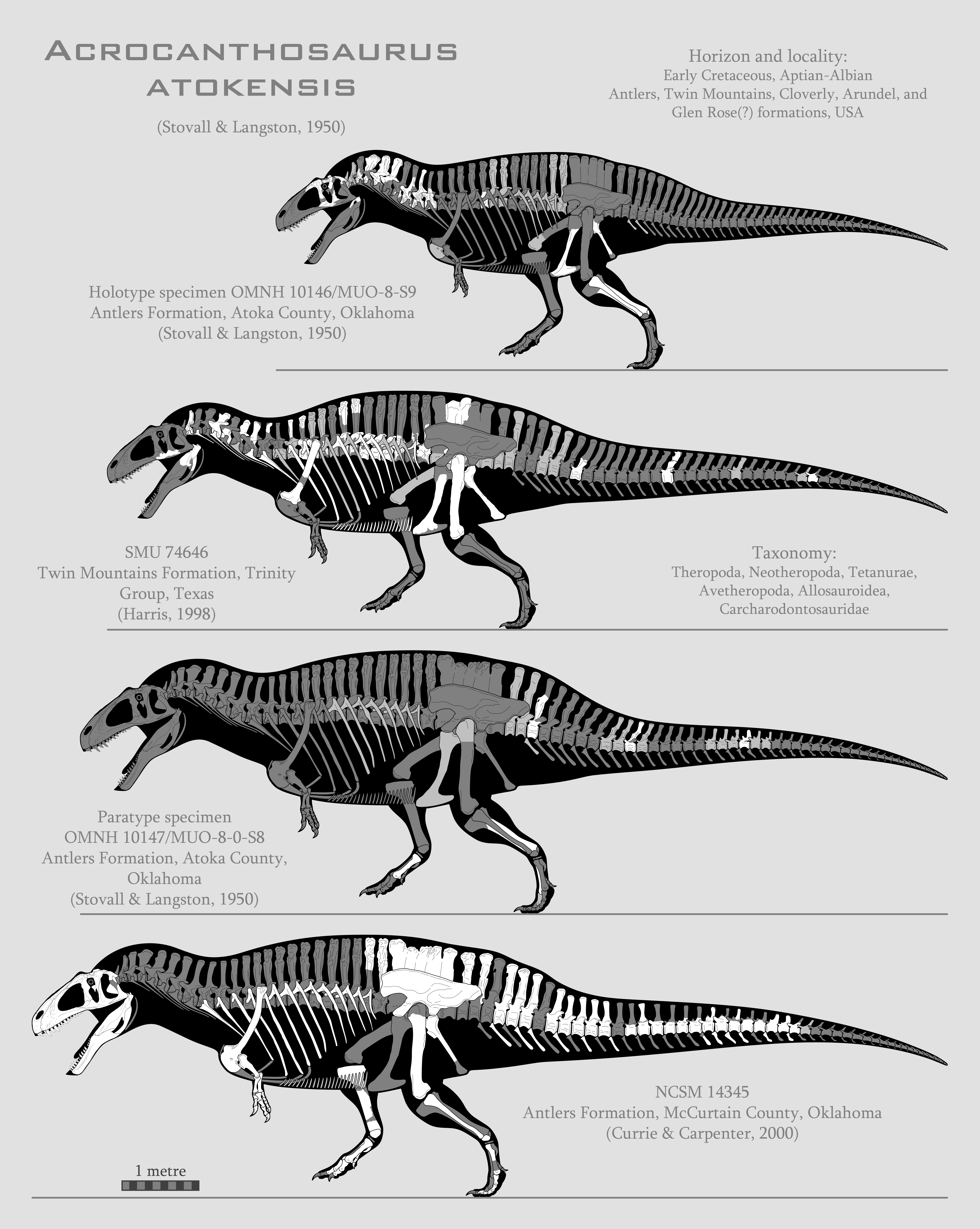Acrocanthosaurus atokensis (“High-spined reptile from Atoka”) is a species of gigantic theropod dinosaur that lived in what is now North America during the Early Cretaceous. It grew to be one of the largest theropods known from North America, rivalling adult Tyrannosaurus rex in size, and indeed one of the largest theropods known from the world, with NCSM 14345 probably massing more than 6 tonnes in life based on volumetric estimates, easily on par with large bull African elephants. Skeletal elements of the paratype specimen OMNH 10147 are roughly the same size as comparable bones from NCSM 14345, indicating an animal of roughly similar overall body size. It is one of the oldest known supergiant carcharodontosaurids, dating from the Aptian-Albian stages (between ~120-110 Ma).
Nearly the entire skeleton of A. atokensis is known, but it is between several specimens that are, individually, not very complete. The most complete specimens are SMU 74646 and NCSM 14345, the former of which preserves the most complete axial column known for the taxon so far and is thus used to fill in missing portions of the other specimens’ axial columns, and the latter preserves a virtually complete skull. The only portion of the skeleton not represented by any A. atokensis specimen, the distal caudals, are filled in based on Concavenator corcovatus.
The most prominent feature of A. atokensis is the tall dorsal ridge that the taxon is named after, which likely anchored massive axial musculature and would have been an extension of the creature’s back in life, much like in iguanodonts and bovids. While other carcharodontosaurids also possess tall dorsal spines, few possess tall spines of this magnitude, and no other carcharodontosaurid with preserved cervical material so far shows the tall dorsal ridge continuing over the cervicals and into the axis.
This feature seems to be rather variable between adult A. atokensis specimens – SMU 74646 possesses a shorter neural spine in absolute terms than the much smaller holotype specimen OMNH 10146 in their overlapping 5th cervicals. The very tall neural spines in NCSM 14345 (also known as “Fran”) as restored in the mounted skeleton seem to be legitimate, as the posterior dorsal neural spines from the last two dorsal vertebrae are largely preserved, as well as the five fused sacral neural spines.
The limbs of A. atokensis are rather short in proportion to its body size, and combined with the added bulk from the hypertrophied axial musculature suggested by the neural spines, suggests an animal clearly built for brute strength over speed.
Some elements, namely the fibulae from the holotype, the forelimbs, femora, and 4th toe from NCSM 14345, and the second metatarsal from the paratype, have been swapped left & right in order to show the preserved bones better. Bones which are well-illustrated in the description or external photographs are in white, while bones which are unillustrated or poorly-illustrated are in light grey. A few bones from certain specimens have been excluded from this reconstruction as their placement on the skeleton cannot be determined with the current data.
Reconstructed dimensions
- OMNH 10146/MUO-8-0-S9
- Hip height: ~2.39 metres
- Shoulder height: ~2.27 metres
- Back height: ~2.79 metres
- Total height: ~2.81 metres
- Standing length: ~8.62 metres
- Axial length: ~8.9 metres
- SMU 74646
- Hip height: ~2.64 metres
- Shoulder height: ~2.44 metres
- Total height: ~3.05 metres
- Standing length: ~10.78 metres
- Axial length: ~11.09 metres
- OMNH 10147/MUO-8-0-S8
- Hip height: ~2.94 metres
- Shoulder height: ~2.71 metres
- Total height: ~3.37 metres
- Standing length: ~11.12 metres
- Axial length: ~11.46 metres
- NCSM 14345
- Hip height: ~2.93 metres
- Shoulder height: ~2.7 metres
- Total height: ~3.36 metres
- Standing length: ~11.74 metres
- Axial length: ~12.08 metres
References
- Stovall & Langston, 1950, “Acrocanthosaurus atokensis, a new genus and species of lower Cretaceous theropoda from Oklahoma”
- Harris, 1998, “A reanalysis of Acrocanthosaurus atokensis, it’s phylogenetic status, and paleobiogeographic implications, based on a new specimen from Texas”
- Currie & Carpenter, 2000, “A new specimen of Acrocanthosaurus atokensis (Theropoda, Dinosauria) from the Lower Cretaceous Antlers Formation (Lower Cretaceous, Aptian) of Oklahoma, USA”
- Eddy & Clarke, 2011, “New information on the cranial anatomy of Acrocanthosaurus atokensis and its implications for the phylogeny of Allosauroidea (Dinosauria: Theropoda)”
- Bates et al., 2009, “Estimating mass properties of dinosaurs using laser imaging and 3D computer modelling”
- Fidalgo, 2017, “Concavenator corcovatus (Theropoda, Dinosauria) from Las Hoyas fossil site (Early Cretaceous, Cuenca, Spain): taphonomic, phylogenetic and morphofunctional analyses”
- Theropod Database – Acrocanthosaurus atokensis
- BHI Acrocanthosaurus atokensis file
- Acrocanthosaurus atokensis NCSM mounted skeleton
Published: November 3, 2018
Last update: September 19, 2021
